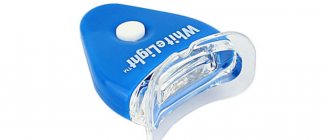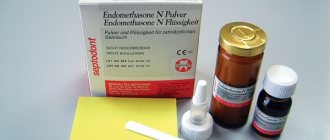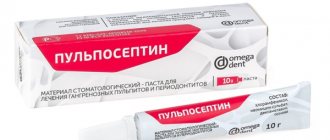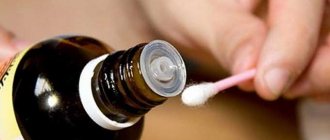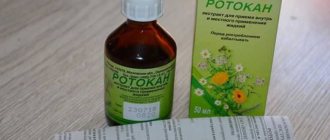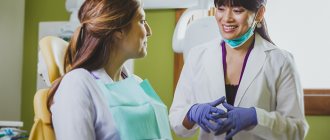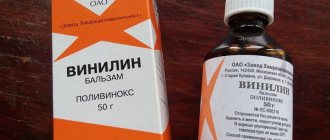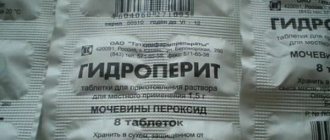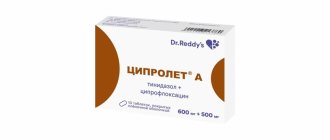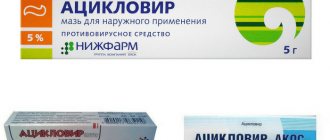Decasan is an antiseptic drug, which is a 0.02% solution of decamethoxin in a 0.9% sodium chloride solution in bottles.
The Yuria-Pharm company produces the drug in vials for external and intracavitary use, and for the treatment of respiratory infections there is a form of release in nebulas (sterile single-dose containers).
Antiseptics are drugs that are used to disinfect surfaces, equipment, wounds, skin and mucous membranes. Some of them have the effect of inhibiting the reproduction and growth of bacteria, others directly destroy microbes.
Decamethoxin is a surfactant. The mechanism of the antimicrobial action of decamethoxin is based on disruption of the permeability of the cell membrane, inactivation of the exotoxin and inhibition of protein synthesis of microorganisms.
- Bactericidal effect - against staphylococci, streptococci, diphtheria and Pseudomonas aeruginosa;
- fungicidal effect - against many types of fungi (aspergillus, yeast);
- highly active against microorganisms resistant to antibiotics - penicillin, chloramphenicol, tetracyclines, streptomycin, etc.
- anticystoid (Trichomonas, Giardia) and viruscidal effects.
Decamethoxin is able to reduce exudation by inhibiting the production of serotonin by cells.
A unique property of Decasan is the lack of interaction with human cells, due to which it is not absorbed from the surface of the mucous membranes, so there is no risk of systemic side effects. Does not cause irritation of mucous membranes, and consequently, local undesirable manifestations.
It should be noted that Decasan can increase the sensitivity of microorganisms to antibiotic therapy.
The drug is widely used in outpatient and clinical practice; it is effective for abscesses, carbuncles, purulent-inflammatory processes of soft tissues, bacterial and fungal skin diseases.
In addition to external use, it has been shown to be effective as an inhaled drug for pneumonia and diseases of the upper and lower respiratory tract.
The drug has a large evidence base of effectiveness and safety of use. A wide range of antimicrobial, antifungal and antiviral effects with an almost complete absence of side effects allows Decasan to be used as an antiseptic for various therapeutic and prophylactic purposes.
Peculiarities
Decasan has an antimicrobial antifungal effect, concentrates on the cytoplasmic membrane (CPM) of the microbial cell and connects with phosphatidic groups of membrane lipids, disrupting the permeability of the CMP of microorganisms. Decamethoxin has a pronounced bactericidal effect on staphylococci, streptococci, diphtheria and Pseudomonas aeruginosa, capsular bacteria and a fungicidal effect on yeast, yeast-like fungi, pathogens of epidermophytosis, trichophytosis, microsporia, erythrasma, some types of mold fungi (Aspergillus, Penici), protistocidal effect on Trichomonas, Giardia, viruscidal effect on viruses. Highly active against microorganisms resistant to antibiotics. Forms resistant to decamethoxin with long-term use are formed slowly and in small quantities. Bacteriostatic (fungistatic) concentrations are similar to its bactericidal (fungicidal), virusicidal, protistocidal concentrations. During treatment, the sensitivity of antibiotic-resistant microorganisms to antibiotics increases.
Pharmacological action of Decasan
The main principle of the drug's operation is that it can make the target cell membrane almost impenetrable, which occurs due to the connection with lipid structures in the region of their phosphatidic groups. Due to the fact that the membrane changes its permeability, homeostasis is disrupted directly in its internal part, and the virus is completely destroyed. Decasan is completely safe for humans, since it does not have any negative effect on the total number of cells in the entire body.
Also in the instructions for Dekasan it is noted that as a result of numerous experiments and analyzes it was found that it causes the final death of a fairly large number of strains of gram-negative and gram-positive microorganisms. These include pathogens of diphtheria, staphylococci, streptococci, pathogens of Pseudomonas aeruginosa, etc. Decasan has a disinfectant effect on trichophytes, epidermophytes, yeast-like fungi, erythrasmas and other mold-like fungi. The drug exerts its antiprotozoal ability by acting directly on Trichomonas and Giardia. Decasan is a universal remedy in the fight against viruses. During the research, it was found that there are no bacteria in nature that it cannot cope with. The bacteriostatic effect of Decasan can be considered the initial stage of bactericidal manifestation.
Decasan is practically not absorbed into the blood and does not penetrate the skin and mucous membranes.
Indications
Treatment of pustular bacterial and fungal skin diseases, microbial eczema, purulent-inflammatory lesions of soft tissues (abscesses, carbuncles, phlegmons, boils, purulent wounds, panaritiums) dental diseases (stomatitis, ulcerative-necrotic gingivitis, dystrophic-inflammatory form of periodontal disease I-II degrees in the acute stage).
Also indicated for lung abscess, bronchiectasis, cystic hypoplasia of the lungs, complicated by suppuration, chronic bronchitis in the acute phase, chronic tonsillitis, tonsillitis, carriage of staphylococci and diphtheria bacilli, ulcerative colitis, paraproctitis.
In gynecological practice - for the treatment of candidiasis of the vaginal mucosa, inflammatory diseases of the genitals of microbial origin, prenatal sanitation of the birth canal, treatment of postpartum endometritis.
Purulent-inflammatory diseases of the abdominal and pleural cavities.
For hygienic disinfection of the skin of medical staff's hands and rubber gloves when examining patients and performing medical procedures and minor surgical interventions, pre-sterilization disinfection of medical instruments and diagnostic equipment made of metals, rubber, polymeric materials and glass.
Nasal rinsing is an addition to rinsing
Often, diseases of the upper respiratory tract are accompanied by a runny nose, nasal congestion and swelling. To speed up treatment, you can supplement the rinsing with nasal rinsing - this will help relieve swelling and restore the ability to breathe normally .
No more than 20 ml per day is used, and procedures should be carried out no more than two or three times. Once a day is too little. More than three is too many. The pure drug is used only for serious pathologies. For a common runny nose accompanying a sore throat, it is usually diluted in a ratio of 1:7 with filtered water or saline. Rinsing is possible in a lightweight version, which requires a soft rubber bulb - the smallest of those that can be bought at a pharmacy. You should:
- blow your nose - thoroughly, so as to completely clear the nasal passages, and if this is not possible, use vasoconstrictor drops;
- take the preparation into the bulb and lubricate its tip with Vaseline;
- carefully insert the nose of the pear into your nose, tilt your head back slightly and press slowly, smoothly - as a result, the water should go up the nostril and exit through the other nostril;
- Repeat the entire procedure from the second nostril.
You need to continue until the required amount of solution is used up, which should not be too large. But if you don’t want to buy a pear and have enough time and skill, you can learn how to rinse manually using the guide:
- blow your nose - manually or using vasoconstrictor drops;
- take the drug into your palm;
- bend your head and suck in the contents of your palm through one nostril.
If everything goes right, Dekasan will pass through the nostril and out the other, flushing out bacteria and relieving swelling . It is important to remember that children can only rinse their noses using the first method.
Despite all its benefits, using Dekasan at home as the only drug for the treatment of sore throat, laryngitis or tonsillitis is a bad idea. Treatment must be comprehensive. Only then will it bear fruit.
Directions for use and doses
For purulent and fungal skin lesions, purulent wounds, use the solution in the form of rinses and lotions. For the treatment of proctitis and ulcerative colitis, administer a warm solution in the form of enemas of 50-100 ml 2 times a day until the signs of acute inflammation completely disappear. Fistulas with chronic paraproctitis should be washed with Decasan ® daily for 3-4 days. To wash the bladder in adult patients, use decamethoxin solution after preliminary dilution 1:7 with purified water in a dose of 500-600 ml (7-20 washes per course of treatment).
Damage to the oral mucosa is treated by applying 25-50 ml for 10-15 minutes or rinsing (100-150 ml). The dystrophic-inflammatory form of periodontal disease I-II in the acute stage is treated by irrigating pathological gum pockets with a warm solution (50-70 ml) or applying applications to the gums to attenuate inflammatory phenomena. Patients with candidiasis of the oral mucosa and ulcerative-necrotizing gingivitis should be prescribed mouth rinses (100-150 ml) 4 times a day for 5-10 days.
Treatment of candidiasis of the tonsils and chronic tonsillitis is carried out by washing the lacunae of the palatine tonsils (50-75 ml per wash).
Sanitation of carriers of staphylococcus and diphtheria bacillus is carried out by rinsing the pharynx with a solution, washing the lacunae, irrigating the nasopharynx and tonsils. Wash the lacunae 3-5 times every other day.
In adults with lung abscess, bronchiectasis, cystic hypoplasia of the lungs complicated by suppuration, chronic bronchitis in the acute phase, administer Decasan ® endobronchially:
- through a microtracheostomy 25-50 ml 1-2 times a day; through a transnasal catheter 5-10 ml 1 time per day
- by ultrasonic inhalation method, 5-10 ml 1-2 times a day;
- using lavage of the tracheobronchial tree in a volume of 100 ml.
Duration of treatment is 2-4 weeks.
When treating purulent-inflammatory diseases of the abdominal and pleural cavities, fill the affected area to the brim with Decasan ® with an exposure of at least 10 minutes. If necessary, including when suturing “tightly” (without drainage), carry out repeated filling of the operating cavity with subsequent removal of the solution to clean rinsing water. Flow-flushing drainage of the cavity is performed using drains or the puncture method.
For the treatment of microbial and fungal trichomonas lesions of the vaginal mucosa, use Decasan ® in the form of douching (50-100 ml of the drug heated to 38 ° C 3 times a day). In the same way, carry out prenatal sanitation of the birth canal once. Treatment of postpartum endometritis is carried out by washing the uterine cavity with a warm preparation (150-200 ml) 2 times a day.
Disinfection of the skin of hands and rubber gloves is carried out by applying 5-10 ml of the drug to a previously washed surface to be disinfected for 5 minutes.
Children: Disinfect cleaned medical instruments, mouthpieces, tubes and equipment by immersing them in the solution for 30 minutes.
Use for the treatment of children over 12 years of age with chronic bronchitis in the acute phase, using ultrasonic inhalation, 5-10 ml 1-2 times a day. For other indications, there is no experience of use in children under 18 years of age.
Actual information
Decasan (active ingredient - decamethoxin), according to the AT classification, belongs to the group of antiseptic and disinfectant medicines. it has a wide range of antimicrobial, antifungal and antiviral effects due to the ability to interact with phosphate groups of lipids of the cytoplasmic membrane of microorganisms and thus disrupt its permeability and lead to cell destruction. decamethoxin has been used in clinical practice since the 1970s to the present day with consistently high efficiency and has a wide range of indications for use.
Mechanism of action of decamethoxin
As a result of research, it was found that decamethoxin has a bactericidal effect on Pseudomonas aeruginosa, as well as Escherichia coli and Micrococcus lysodeikticus. Due to the fact that decamethoxin is a surfactant, it changes the permeability of the pathogen membrane, leading to the destruction and death of the microorganism, which determines its bactericidal effect (Shchetina VN et al., 1990). The bacteriostatic effect is due to the following mechanisms: inactivation of pathogen exotoxins (Kovalchuk V.P., 2002); reduction of adhesion of pathogenic microorganisms (Zhornyak OI et spivat., 2010).
An in vitro study demonstrated the antifungal effectiveness of decamethoxin against Candida fungi isolated from patients with chronic intestinal diseases. It has also been established that drug resistance to decamethoxin develops very slowly and does not reach a high level (Palii GK, Ivanova SA, 1986).
The effectiveness of Decasan in surgery
A recent clinical study presents the experience of treating 17 patients with cholangitis of various origins using the antiseptic Decasan
. The clinical effectiveness of the drug in the complex therapy of cholangitis was noted, confirmed by the results of a bacteriological study of bile (Aripova NU, Magzumov I.Kh., 2014).
Efficiency of Dekasan
in the treatment of cholangiogenic liver abscess was demonstrated in a clinical study.
The results of treatment of 47 patients with cholangiogenic liver abscess are described. The study proved the effectiveness of sanitation of the abscess cavity with Decasan
(Nychytailo MI et al., 2005),
Dekasan
proposed for use in the complex treatment of infected pancreatic necrosis and its complications (Nichitailo ME, 2010), as well as in the treatment of acute abdominal infectious pathologies of various origins (Fomin PD et al., 2009).
Another study presents the results of complex therapy of 37 patients operated on due to the development of acute abdominal surgical diseases. 22 patients received local therapy with a 0.02% antiseptic solution of decamethoxin. There was a positive effect on the clinical course of diseases, a decrease in the frequency of purulent-septic complications, in particular in patients operated on for acute necrotizing pancreatitis (Konovalov EP, 2004).
The experience of treating 91 patients with peritonitis of various origins using the antiseptic Decasan
. There was marked clinical effectiveness compared to other antiseptics in the complex treatment of peritonitis (Nazirov FN, 2014).
Based on the analysis of research results, it was found that the use of a cationic antiseptic solution (including a 0.02% decamethoxin solution) for sanitation of the abdominal cavity can reduce microbial contamination during sanitation, and also due to this, the frequency of postoperative complications in surgical peritonitis and the number of cases of lethal outcome (Boiko VV et al., 2012).
of Decasan was analyzed in 102 patients
in the treatment of purulent infections of the pararectal area.
According to the data obtained, Decasan
is an effective drug for local therapy of this pathology (Zakharash MP, 2011).
Decamethoxin has also proven itself as an effective drug for preventing suppuration of postoperative wounds after excision of pararectal or coccygeal epithelial cysts (Klimenko AN, Iukhimets AD, 1982).
In one of the clinical studies, the effectiveness of Decasan
in complex therapy of soft tissue necrosis, which resulted in sepsis.
Sepsis is a severe generalized infection usually caused by pathogenic bacteria. It often causes hospitalization and death. The experience gained as a result of the study contributed to a better understanding of the pathomechanisms of this condition, the development of therapy aimed at improving the general condition of patients, and also necessarily including the local use of antibacterial and antiseptic agents in the purulent focus. The study included 192 patients (103 women, 89 men). According to the classification of septic conditions (Chicago, 1991), patients were divided into 3 groups: group 1 - with a local form of infection, group 2 - with systemic inflammatory response syndrome (SIRS, English abbreviation SIRS), which lasts up to 72 hours , 3rd group - with various forms of sepsis, in which SIRS lasts 72 hours or more. In patients whose wounds were treated with Decasan
, a decrease in the severity of pain, tissue swelling, early sanitation of the wound and early appearance of granulation in the wound were noted.
The algorithm for the treatment of sepsis proposed by the authors includes an integrated approach to the treatment of infection through early surgical intervention, intensive supportive care, etiotropic antibacterial therapy and local use of antiseptic therapy with Decasan
.
As a result, it was concluded that Decasan
can be recommended for the disinfection of skin, mucous membranes and wounds in areas of infection caused by bacteria, fungi and protozoa (Fuss J., 2016).
Decamethoxin can also be used to treat burn disease. One clinical study identified the etiology of infectious complications in 71 patients with severe burns. It has been established that the main causative agents of infection in patients with burn disease are S. aureus (35.9%), A. baumannii (25%), P. aeruginosa (12.82%), P. mirabilis (5.12%). Decasan antiseptic solutions has been proven
, miramistin, chlorhexidine. In relation to staphylococcus, high antimicrobial properties of dressing materials, which contain ions of decamethoxin, chlorhexidine, furagin, and silver, have been noted. The clinical effectiveness of the use of materials impregnated with the antimicrobial composition decamethoxin with carboxymethyl starch, hydroxyethylcellulose and polyvinyl acetate, used for the prevention and treatment of infectious-purulent-inflammatory complications in patients with burns, has been proven (Nazarchuk OA, 2016).
Another study presented the results of an observation of 154 patients with open traumatic brain injury. The effectiveness of decamethoxin in patients with purulent-inflammatory complications was confirmed (Pedachenko EG et al., 1992).
Decamethoxin has been widely used as an antiseptic in surgery for many years. Thus, in a clinical study, the advantages of its use in the treatment of purulent processes on the hand (Kravets VP, 1987) and in the complex treatment of complicated forms of paronychia (Palii GK et al., 1988) were demonstrated.
In another study, which involved 286 patients with purulent-inflammatory diseases of the fingers and hands (196 patients (68.5%) with panaritium, 82 (28.7%) with phlegmon and abscesses, 6 (2.1 %) - with boils and 2 (0.7%) - with carbuncles), the effectiveness of the use of decamethoxin as part of the complex treatment of this pathology was confirmed (Fishchenko A. et al., 1992).
The effectiveness of decamethoxin in the treatment of respiratory diseases
Decamethoxin has also demonstrated its effectiveness in otolaryngology. Clinical studies have shown the effectiveness of the use of decamethoxin by inhalation in the treatment of nonspecific diseases of the respiratory tract in children (Kravets AA et al., 1976).
Decamethoxin has demonstrated effectiveness in the treatment of diseases of the oral mucosa (Palii GK et al., 1975), as well as in the treatment of chronic tonsillitis (Zubovich AP, 1978). Studies have determined the sensitivity of pathogenic microflora isolated from children with respiratory tract diseases to decamethoxin (Palii GK, 1974). Decamethoxin can be used for preoperative preparation of patients with nonspecific respiratory diseases (Iukhimets VA, 1985).
Decamethoxin in complex therapy combined with antibiotics is effective in the treatment of purulent-inflammatory diseases of the respiratory system (Radionov BV et al., 1986). The effectiveness of decamethoxin in the complex treatment of chronic bronchitis has also been confirmed by clinical studies. The study involved 72 patients with chronic bronchitis (catarrhal, purulent, and purulent bronchitis complicated by purulent destructive processes). All patients received complex therapy using decamethoxin as a local antibacterial agent. This study found that the inclusion of decamethoxin in complex therapy is effective not only due to its direct antiseptic effect, but also due to the fact that this drug reduces the resistance of microorganisms to antibiotics (Iukhimets VA, Pilipchuk VN, 1990).
Dekasan
has a very wide range of indications for use.
Thus, the use of decamethoxin in the complex therapy of chronic gastritis in combination with biliary tract pathology was proposed (Mokhun' IK et al., 1982). Safety of Decasan established as a result of research
Currently, special attention is paid to the safety of the use of local antiseptics and their effect on the cell cycle, as well as indicators such as DNA fragmentation and apoptosis. In a study on rats, it was demonstrated that Decasan
with higher antimicrobial effectiveness, it is a safer antiseptic than Miramistin. It was demonstrated using flow cytometry that decamethoxin had a minimal proapoptotic effect on rat corneal cells after 2 weeks of drug use. It was also noted that the decrease in cell proliferation was insignificant, as was the increase in nuclear DNA fragmentation. This indicates the absence of the cytotoxic effect of decamethoxin. When studying similar parameters after the use of miramistin, a decrease in the mitotic activity of cells, a significant increase in DNA fragmentation and an increase in apoptosis were revealed, which indicates a higher safety profile of decamethoxin compared to miramistin.
A morphological study was carried out to study the local effect on tissue. Special textiles were impregnated with a mixture of decamethoxin and modified polysaccharides. Based on the results of the study, it was found that there is no toxic effect of antiseptic medical textiles impregnated with decamethoxin on the tissue of the macroorganism. At the same time, a positive effect was observed on the course of regenerative processes, epithelization of wounds, anti-edematous and anti-inflammatory effects (Nazarchuk OA, 2013).
conclusions
Dekasan
- an antiseptic indicated for use in a wide range of infectious and inflammatory diseases.
Its effectiveness and safety have been confirmed in clinical studies. The use of Decasan
for local sanitation of the source of infection can reduce the need for antibiotics, as well as increase the sensitivity of microorganisms to antibiotics when used in combination with
Decasan
.
This drug has no toxic effect. The only contraindication for use is individual intolerance to decamethoxin. There are no restrictions on the use of Decasan
during pregnancy and lactation.
As a surface-active cationic antiseptic, Decasan
is incompatible with soap and other anionic surfactants.
Product description certified by the manufacturer Yuria Pharm
.
Verified by
Likar Turumkulova Irina
Note!
Description of the drug Decasan solution 0.2 mg/ml bottle. 200ml on this page is a simplified author’s version of the apteka911 website, created on the basis of the instructions for use.
Before purchasing or using the drug, you should consult your doctor and read the manufacturer's original instructions (attached to each package of the drug). Information about the drug is provided for informational purposes only and should not be used as a guide to self-medication. Only a doctor can decide to prescribe the drug, as well as determine the dose and methods of its use.
How to rinse correctly
For a course of treatment to be effective, it is not enough to just calculate the dose. You also need to rinse correctly, following the instructions:
- pour Dekasan into a glass ( it is important to choose a glass that you won’t mind using for a while only for rinsing and that no one else in the family will take - this is necessary to prevent the possibility of infection);
- rinse your mouth thoroughly with it so as to wash away the infection from the tongue and cheeks from the inside;
- take a little medicine into your mouth and tilt your head back;
- open your mouth and, holding your throat so as not to accidentally swallow Dekasan, begin to pronounce some long vowel sound - “a-a-a”, “o-o-o”;
- continue for about thirty seconds - in order to determine the time, you can count to yourself to thirty or sing a verse of your favorite song to yourself;
- lower your head and spit out the medicine.
You need to continue until the Dekasan in the glass runs out.
It is very important not to do everything too quickly, otherwise the drug will not have time to have any beneficial effect.
Reviews
As a rule, patients who have undergone a course of conservative treatment with this pharmaceutical drug leave positive reviews on thematic forums. It is interesting that information about the medicine and reports on the completion of appropriate therapy can be found in various fields of medicine, because Decasan enjoys a good reputation in gynecology, surgery, urology, internal medicine and pediatrics.
Separately, it should be noted reviews related to the elimination of respiratory nosological entities using this pharmaceutical drug. Of course, most grateful patients advocate for the nebulizer form of the medicine, because in this way the course of conservative sanitation becomes much more convenient and takes less time. The period of manipulation itself is also characterized on the positive side; patients can calmly work at the computer or engage in other extraneous activities.
Interaction
The main active ingredient has cationic surfactant properties , which partly determines its therapeutic effect, and therefore is not compatible with pharmaceuticals that exhibit anionic activity (for example, soap).
A non-drug interaction is an increase in the sensitivity of resistant strains of microorganisms to various types of antibiotics , which implies abundant use of the drug in surgical practice.
Contraindications
Individual hypersensitivity to the components of the drug.
Decasan is an antiseptic drug, which is a 0.02% solution of decamethoxin in a 0.9% sodium chloride solution in bottles.
The Yuria-Pharm company produces the drug in vials for external and intracavitary use, and for the treatment of respiratory infections there is a form of release in nebulas (sterile single-dose containers).
Antiseptics are drugs that are used to disinfect surfaces, equipment, wounds, skin and mucous membranes. Some of them have the effect of inhibiting the reproduction and growth of bacteria, others directly destroy microbes.
Decamethoxin is a surfactant. The mechanism of the antimicrobial action of decamethoxin is based on disruption of the permeability of the cell membrane, inactivation of the exotoxin and inhibition of protein synthesis of microorganisms.
- Bactericidal effect - against staphylococci, streptococci, diphtheria and Pseudomonas aeruginosa;
- fungicidal effect - against many types of fungi (aspergillus, yeast);
- highly active against microorganisms resistant to antibiotics - penicillin, chloramphenicol, tetracyclines, streptomycin, etc.
- anticystoid (Trichomonas, Giardia) and viruscidal effects.
Decamethoxin is able to reduce exudation by inhibiting the production of serotonin by cells.
A unique property of Decasan is the lack of interaction with human cells, due to which it is not absorbed from the surface of the mucous membranes, so there is no risk of systemic side effects. Does not cause irritation of mucous membranes, and consequently, local undesirable manifestations.
It should be noted that Decasan can increase the sensitivity of microorganisms to antibiotic therapy.
The drug is widely used in outpatient and clinical practice; it is effective for abscesses, carbuncles, purulent-inflammatory processes of soft tissues, bacterial and fungal skin diseases.
In addition to external use, it has been shown to be effective as an inhaled drug for pneumonia and diseases of the upper and lower respiratory tract.
The drug has a large evidence base of effectiveness and safety of use. A wide range of antimicrobial, antifungal and antiviral effects with an almost complete absence of side effects allows Decasan to be used as an antiseptic for various therapeutic and prophylactic purposes.
For children
Decasan for nebulizer is actively used in pediatric practice, since it is the optimal form of spraying a pharmaceutical drug for the gentle elimination of pathologies of the respiratory tract , because the mucous membrane is not yet fully developed during certain periods of growing up (this method of administration allows you to get rid of some possible adverse effects of therapy). convenient for children to use Dekasan for a nebulizer than nasal drops or any other methods of delivering the active components of the drug to the affected layers of the bronchial tree , because it is quite difficult to sit a small child in one position for a long time and correctly insert a catheter into the child’s nose, for example.
In turn, during inhalation with a nebulizer, children can maintain a moderate level of activity It is also possible to watch cartoons or read books, because the mask of the device is practically not felt on the face after the first inhalation.
Decasan for inhalation for children, of course, should be diluted somewhat stronger than for adult patients. As a rule, half dosages of the drug are used, but for precise instructions you should additionally consult a qualified pediatrician.
